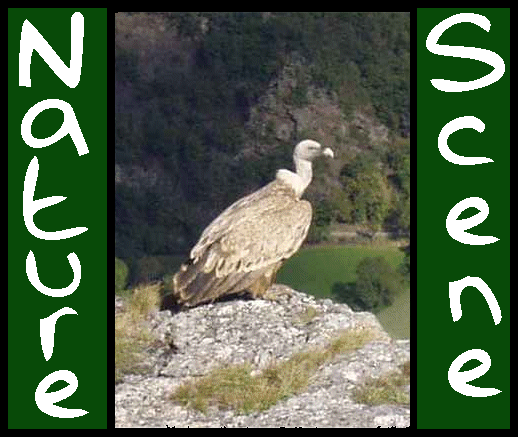
Welcome to NATURESCENE'S
BOTANY ARTICLES of the CÉVENNES
A selection of articles in French and English by David Dickenson of Naturescene, and Alain Jacquet of ALEPE, written for the official ALEPE site

|
Alain has the privilege to begin: We were a group of eight at the Barre des Cévennes for the outing. Under a sunny but threatening sky, we set off along the D983 towards the marshland around Le Pesquier. Attracted by a meadowland where we could see some spikes of Fragrant Orchid (Gymnadenia conopsea), we made our way forward .... and discovered no less that 10 species of orchids within a few dozen square metres! Elderflower Orchids (Dactylorhiza sambucina) faded, but easily identifiable, Burnt Orchids (Neotinea ustulata) and Early Purple Orchids (Orchis mascula), Greenwinged Orchids (Anacamptis morio) and Bug Orchids (Anacamptis coriophora) in amongst the maiden pinks, self-heals and a yellow carpet of rockroses. |
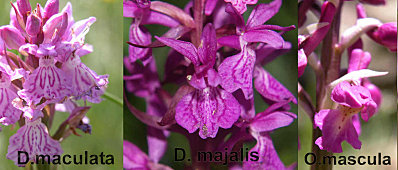
Photo 1 |
The drooping tongue of the Greater Butterfly Orchid (Platanthera chlorantha) attracted us close to a stream, where we were able to study the differences between the genera Dactylorhiza and Orchis, by comparing the Heath Spotted Orchid (Dactylorhiza maculata),and the Broad-leaved Marsh Orchid (Dactylorhiza majalis) with the Early Purple Orchid (Orchis mascula) (photo 1), all resembling each other. We were also surprised to discover some Twayblades (Listera ovata)in the middle of the grassland. These are normally lovers of the forest floor. |
|
The path which leads to Le Pesquier was so overgrown that we had to move back to the road to make a detour around the farm of
St. Pierre. But here also the paths were obstructed! Part of the group beat their way back, but the more intrepid members
fought their way through the undergrowth. We saw several typical Heath Spotted Orchids Dactylorhiza maculata), and then the Spotted Orchid (Dactylorhiza fuchsii)(photo 2), also typical, with their very long middle lobe and rounded basal leaf ... in an pine wood, on acid soil .... ! With several specimens, we could distinguish that the floral spike of the D. fuchsii was pyramidal, whereas the spike of D. maculata was cylindrical. One specimen reminded us that the form of the petals was not a reiable criteria for identification: the flowers resembled D. maculata at the top, and but resembled D. fuschsii at the bottom of the same flower spike!!!! |
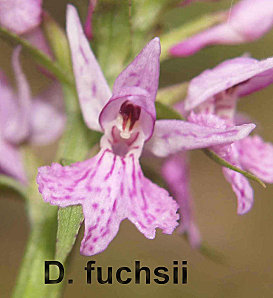
Photo 2 |
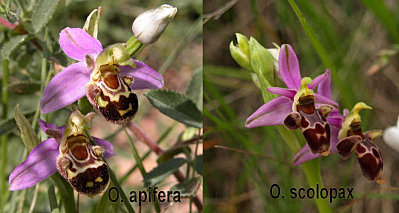
Photo 3 |
|
We found the lost track to Le Pesquier, and the
Bug orchids (Anacamptis coriophora) were abundant on this bare soil, running with water.
As we arrived on the southerly-exposed slope overlooking the marshlands of Le Pesquier, we came across some magnificent Woodcock Orchids (Ophrys scolopax), a sign of the water charged with calcium carbonate running through this sandy soil composed of quartz grains. Effectively, the limestone rocks of the extreme north of the Can de l'Hospitalet are several metres above these sands, derived from the erosion of arkose, a coarse-grained sandstone. The presence a little further on of a clump of Bee Orchids (Ophrys apifera)(photo 3) allowed us to observe the differentiating criteria of these two species. |
| As we climbed up the other side towards the edge of the woods, we came across the Fragrant and Early Purple Orchids (Gymnadenia conopsea and Anacamptis coriophora) again. It was here we were able to identify several stalks of the Lesser Butterfly Orchid (Platanthera bifolia). After careful examination, we were able to tell the two species of butterfly orchid apart (photo 4). |
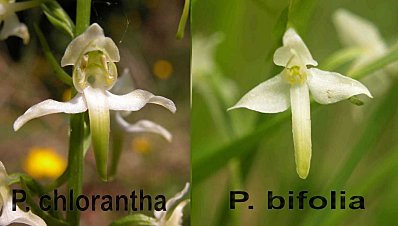
Photo 4 |
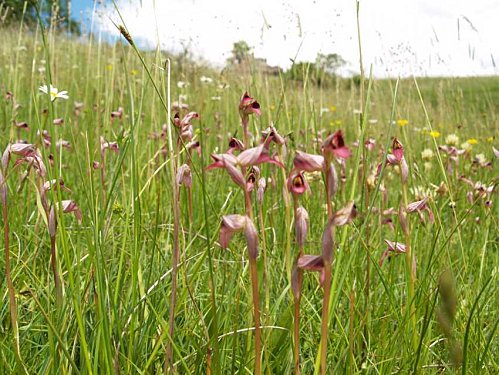
|
And then we saw the Tongue Orchids (Serapias lingua) (photo 5) "Here, I've found one!", "2", "10", ..... We counted groups of several hundred flower spikes, making several thousand in this extraordinary meadow! |
| Thunderstorms grumbled around us, it was after 3pm, and we decided against doing the full circuit, which passed by the
mill of Géminard, and then over the Castellas. Under several drops of rain, we regained our cars at Barre, left at the start
of the footpath that climbs the Castellas. Several bravehearts wanted to climb this Castellas despite the increasingly
menacing storms, but as time had moved on, the project was abandoned.
To this list of orchids, we could add a few other species that we observed the 6 June 2009 on the Castellas: Orchis militaris and anthropophora, Cephalanthera damasonium together with the Lizard Orchid (Himantoglossum hircinum). This would make a total of 22 species discovered on this walk! |
................. Following text and photos by David Dickenson ................Other flowers of interest |
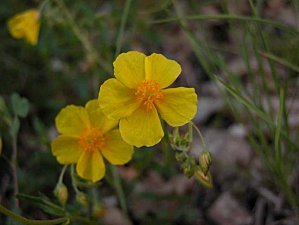
Photo 6 |
In addition to all these orchids, the meadows at the start were rich in both species and in colour. The yellow of the Common Rockrose (Helianthemum nummularium) (photo 6) dominated the 200-odd other species present. The Field Gentian (Gentianella campestris) (photo 7), only 2cm high, is very discrete - 'don't ignore me, I am very cute', it pleaded. |
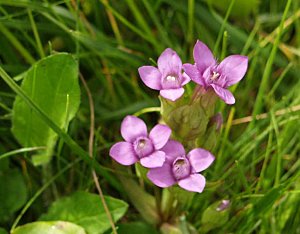
Photo 7 |
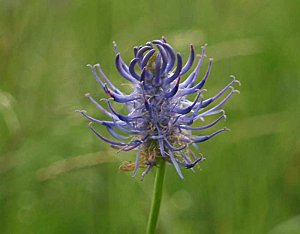
Photo 8 |
In contrast, the rampions proudly threw their flowers up very high above the other vegetation. For me, this appears to be the Spiked Rampion (Phyteuma spicatum ssp. occidentale) (photo 8), but I am ready for somebody to correct me. |
| Another 'star' was the Purple Vipergrass (Scorzonera purpurea) (photo 9), very delicate, and with a very distinctive purple colour. This plant should be taken care of, as it figures on the ZNIEFF list of regional determinant plants |
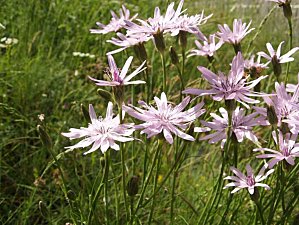
Photo 9 |
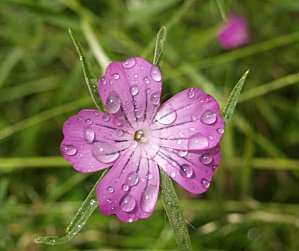
Photo 10 |
In the afternoon, we found another plant that figures on this list, and almost the same strange colour. This was the
Corncockle (Agrostemma githago) (photo 10), with petals arranged like a propeller.
This is seen as a harmful weed of corn fields, and in England, we exterminated this plant 60 years ago, Thus I feel very priviledged to see this ravishing beauty. |
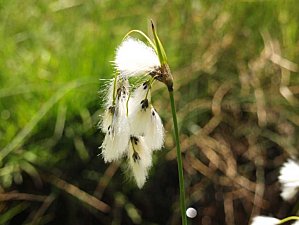
Photo 11 |
We are attracted from afar by the cotton buds of the
Common Cottongrass (Eriophorum angustifolium) (photo 11), always a sure sign of marshland (in England, marshes are
great stuff to explore with all the family, especially the mother-in-law, who can disappear right up to the waist.
We saw another sub-aquatic Gramineae (or Poaceae), not yet in flower. This was the Greater Reedmace (Typha latifolia) (photo 12). For the sake of the lady of our party who was impatient to see it once opened, I attach a photo of the flower. Every Englishman of my generation believes that Moses was hidden amongst the reedmaces, but calls them bullrushes. This is because of a Victorian illustration in the school-issue Bible. In fact, the artist mistook the text 'bullrush', and drew reedmaces. |
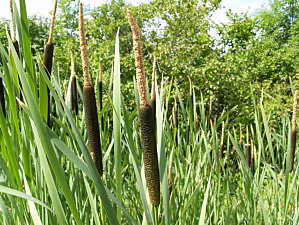
Photo 12 |
| Whilst we were munching through our picnic, one of the party expressed her fear of ticks on the long grass. 'Don't worry', Alain reassured her. 'The ticks here are very polite, because they are into poli-tics'. (photo 13). |
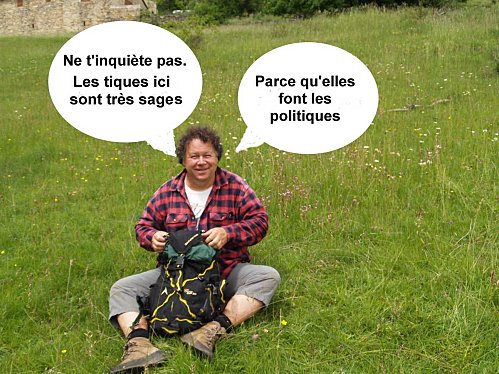
Photo 13 |
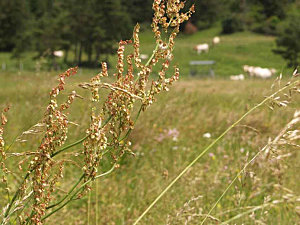
Photo 14 |
The picnic finished, we climbed a little to see the Serapias. Halfway along, Alain pointed out a field full of Common Sorrel (Rumex acetosa) (photo 14), with rusty coloured flowers. 'That plants indicates the end of orchids', he told us. ‘Just a little dung twice a year, and the pasture becomes too rich for the orchids and other flowers that we were admiring this morning’. |
|
I admitted that when I was a veterinary student, we were lectured on the methods to make a pasture very 'rich'. Four species of
grass, cut just after flowering - tolerate nothing else. Nobody took any account of any benefits or loss to the environment, of
nutritional supplements, and above all the health benefits for the livestock. For example, in the field a little lower down,
we had seen lots of
Sainfoin (Onobrychis viciifolia) (photo 15).
The French call it 'sainfoin', or 'healthy hay' for a good reason. It is full of nutrients, and recently some very valuable worming properties have been discovered, leading to international interest in research. |
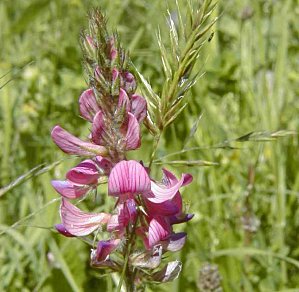
Photo 15 |
|
We continued our road, just a little depressed, when we spotted the Serapias orchids in their hundreds. It is ....
But I just can't find the words for it. Quite simply, it is the Cévennes. | |